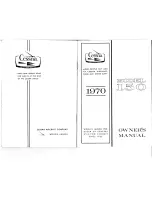
Other Key Components
Engine
The Aircraft has been constructed with a
Yamaha YG3 fuel-injected engine equipped with
a centrifugal clutch connecting a 3.0:1 gear
reduction drive. Refer to publications from
Yamaha for engine maintenance and
performance specifications. The serial number
is listed in the Engine Log.
Propeller
The Aircraft has been constructed with a 69”
3-blade Luga Prop. The blade serial numbers
are listed in the Engine Log. The propeller has
been pitched to allow an engine RPM of 8250
at full throttle with a static thrust of 540
pounds.
Rotor System
The Aircraft has been constructed with 29’ Sky
Wheels fiberglass rotors. However, the rotor
head is the standard Tango 2 model, adapted
to US rotors by installing metric-to-SAE
bushings in the teeter bolt bearing inserts.
Fuel Tanks
The Aircraft is equipped with two, 7 US gallon
fuel tanks for a total of 14 gallons. Regular 87
octane auto gas (with or without ethanol) is the
recommended fuel. The aircraft may be
operated with 100LL AVGAS, however, the time
between oil changes should be halved along
with the spark plug replacement life.
4
Preflight Checklist
It is recommended that the complete preflight
checklist is followed before each flight, even if the
flight is short or just following a previous flight. Any
defects found should be corrected prior to flight.
This checklist is in a basic walk-around format with
the exception of focus on certain critical component
checks that should be performed together.
1. Check fuel level manually. Inspect inside tank for
water or foreign objects. Secure fuel cap.
2. Check starboard side wheel, wheel nut and brake
mechanism. Ensure tire is in good condition and
properly inflated, brakes clear of debris, brake lines
not leaking and wheel nut properly installed.
3. Check battery leads and hold-down straps.
4. Check rear walking beam keel connect pivot point
and starboard rotor control yoke to push-rod tie-rod
end. Ensure no wiring, tubing or cables obstruct
walking beam, yoke or push-rod.
5. Check wiring and lighting along mast is secure.
6. Inspect starboard side of engine. Check motor
mounts secure, muffler secure, water, oil and
vacuum lines secure and not leaking.
7. Inspect rear of engine. Verify pre-rotator belt is in
good condition, pre-rotator actuator and solenoid on
mast in appropriate position (disengaged) and pre-
rotator brake holds drive-shaft secure.
5





























